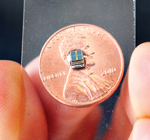Paving the way for ubiquitous computing
Until now, ubiquitous computing has been hampered by the size of necessary batteries—but Ambiq Micro is changing that, with their energy-efficient micro-controllers.

 Enlarge
Enlarge
Measuring just one square millimeter, Ambiq Micro’s prototype microcontroller is approximately 10 times more energy efficient than conventional microprocessors in active mode, and up to 130 times more energy efficient in sleep mode. Product applications for the technology range from medical devices to smart credit cards.

 Enlarge
Enlarge
AMBIQ MICRO | David Blaauw, Scott Hanson, Dennis Sylvester
Imagine a world in which clothing, phones, credit cards, appliances, cars, medical devices, roads, even entire buildings are embedded with tiny intelligent sensors that are constantly monitoring and managing activities.
That phenomenon, called ubiquitous computing, is already underway. But it’s been hampered by the size of the batteries required to power conventional microchips.
All that could change, however, with the October 2010 launch of U-M start-up Ambiq Micro and its energy-efficient micro-controllers.
Ambiq’s breakthrough technology is the result of nearly 10 years of research by U-M Electrical Engineering professors David Blaauw and Dennis Sylvester, with the assistance of research fellow Scott Hanson. The three met when Hanson, a master’s student in electrical engineering at the time, became Sylvester’s research assistant. “A lot of engineering research is a solution looking for a problem,” Hanson says. “Recognizing that, we worked hard to find the right problem to solve.”
In 2005, realizing that many electronic devices are idle for much of the time, the team began developing new technologies to lower microprocessor energy use during sleep cycles. As Sylvester notes, “This low-power technology allowed us to scale the solution down to a much smaller size and extend product lifetime on a much smaller battery.”
One early application of their technology was an implantable device for glaucoma diagnosis and monitoring, developed for the University’s W.K. Kellogg Eye Center. Their faculty collaborator on that project was Dr. Paul R. Lichter, chair of the Department of Ophthalmology and Visual Science.
“That was a tipping point for us, the point at which we asked: what are these applications really good for?” Blaauw recalls. “Working in our favor was the fact that we could make the chips useful across a broad range of applications, from electronics to smart credit cards to wireless sensors in buildings. That versatility enabled us to target a huge range of applications with essentially the same product. The key, we decided, was to tackle them sequentially.”
In 2008, Blaauw, Sylvester, and Hanson engaged Tech Transfer for business development assistance, and to explore funding opportunities for further product development. The result was $150,000 from the College of Engineering Translational Research fund (ETR), and Gap funding through U-M Tech Transfer.
Ambiq Micro was officially launched in the fall of 2010. That same year, the start-up earned $330,000 in business plan competitions, some sponsored by leading venture capital firms such as Draper Fisher Jurvetson.
Now, with the help of U-M Tech Transfer Mentor-in-Residence David Hartmann, the new company has lined up prospective customers in key markets. And with approximately $2 million in venture capital commitments, Ambiq is on track to meet its goal of having sample units in the hands of potential customers in 2011.
Source: Tech Transfer 2010 Annual Report
 MENU
MENU 
